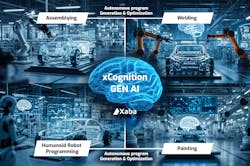Generative AI Catalyzes Growth in Industrial Robotics & CNC Machining
At a Glance:
- Massimiliano Moruzzi, CEO of Xaba, argues that industrial automation is highly inefficient because it relies on outdated controllers, rigid programming and exhaustive manual intervention.
- Programming and deploying industrial robots alone cost the industry $7 billion annually, with 80% of automation costs stemming from manually developing logic for industrial controllers, according to Moruzzi.
- Xaba’s xCognition is AI-powered software that autonomously generates both robotic programs and PLC code based on machine logic and what operators tell them about operational workflows.
As AI finds its way into industrial applications, what matters is not what the technology can do, but whether it can be put to work and achieve impactful business outcomes.
Adding generative AI to the physical product design tool kit can accelerate and advance innovation—but only if manufacturing companies can effectively use the technology, said Massimiliano Moruzzi, CEO and co-founder of Xaba, a Toronto startup that’s bringing generative AI to the factory floor by allowing robots, CNC machines and industrial systems to self-program, self-adjust and run production without a single line of code.
Xaba’s generative industrial AI equips machines with cognitive intelligence. The key part of this “smart brain” is Xaba’s xCognition cognitive control technology, which acts as a central intelligence hub and is specifically designed for factory machines.
xCognition leverages proprietary machine learning algorithms to model the “elasto-mechanical-dynamic behavior of industrial robots and cobots, as well as workpiece variances,” explained Moruzzi, who has pedaled his knowledge as an aerospace engineer and advanced degrees in robotics, cognitive controls and materials science into developing the AI-powered backbone solution.
In other words, Xaba’s generative industrial AI enables machines to autonomously adapt, optimize and execute tasks with precision. At its core xCognition is an AI-powered software solution that can automatically create specific instructions (part programs), as well as the PLC (programmable logic controller) machine logic needed to perform tasks. In essence, it is automation driven by self-programming robots that can easily transition from “text to action.”
A Dynamic Algorithm Can Address the Requirements of Manufacturing Plants
xCognition has been developed to address a definitive problem statement rooted in Moruzzi’s ambition to “bring this new functionality to the industrial masses.” Instead of requiring engineers to spend time writing complex code, machine operators can tell the system what they want the machines to do in plain language (using text). The control AI algorithm then figures out all of the complicated programming behind the scenes, allowing the robots to understand and perform the actions automatically, going directly from text to action.
The technology is groundbreaking because it has the potential to transform factory operations in significant ways. As Moruzzi puts it, a typical scenario at major parts manufacturing facilities 10 years ago would have explained their operations as follows: “An original equipment manufacturers (OEMs) such as General Motors, Stellantis or Ford would approach them and say, ‘We need you to develop a process to produce a million units of this specific part.’ At that time, manufacturing was driven by high-volume, standardized production.”
But that is not the case today because customization in the automotive industry has become increasingly important. “Even for the same car model, you will see year-to-year variances, such as changes to the infotainment system, dashboard layout or other features,” said Moruzzi, who has over the course of his career developed and designed products for Boeing, Lockheed Martin, Airbus and Lamborghini.
Current manufacturing systems rely on rigid, expensive-to-program machines and this level of personalization has become unsustainable. Each new product variation could require building new facilities or costly retooling of existing lines, he said.
Machines equipped with an AI-powered algorithmic solution could mean that manufacturing plants no longer need to be bound by operating on fixed templates or scripts. Instead, they would operate an adaptable algorithmic-driven factory powered by a “synthetic, physics-based brain.” In Moruzzi’s model, operators simply send a new production recipe, allowing the factory to reconfigure automatically.
How AI-powered Machine Solutions Enable Manufacturing
From Moruzzi’s perspective, the industry remains highly fragmented. It faces a significant skills gap, as universities are not adequately preparing students with the required skills to program robots or courses on integrating robots with machining, welding and assembly operations.
To address this in part, Moruzzi says xCognition’s “conditioned synthetic brain” can help at the factory level because it mimics human functionality, which in turn enables smarter control, better coordination and more autonomous operation in manufacturing systems.
The industry’s shortage of skills is also connected to the imperfections of current robotics systems. According to Moruzzi, robot hardware has sufficient mechanical capability and flexibility to perform tasks. However, the limitation lies in the control systems, or “the brain,” which “lacks true understanding of the robot’s capabilities and the surrounding environment,” he said. This results in robots being effectively “incapacitated.”
For example, one of the biggest challenges with programming robotic systems is defining precise trajectories that ensure tasks such as welding, painting, gluing or assembly happen with the desired quality. Current software relies heavily on CAD models and CAM (computer aided manufacturing) systems, which use mathematical abstractions of parts to generate robot paths.
Moruzzi said this approach has fundamental limitations because robots and their environments do not behave like perfect mathematical models. Robots have physical realities; robots respond to environmental forces and face real-world variances that CAD does not capture, he argued. Because of this gap, the instructions sent to robots require extensive human intervention and supervision to correct errors and ensure the task is done properly.
In addition, current robots have a legacy of being “boxed in” (both physically and in terms of their software), he said. Robots come without experience and must be trained in every detail. This makes deployment costly and inefficient.
Moruzzi maintains that an updated and comprehensive platform such as Xaba’s xCognition, which over time learns and gains “experience” or capability with every operation, can benefit both the robot and their human operators.
Applications in Aerospace Have Been Tested
Large-scale robot drilling in aerospace represents the ideal market for Xaba’s technology. In aircraft assembly, drilling millions of holes required to join components is still largely done by hand. “About 80% of the drilling operations remain manual,” said Moruzzi.
Aerospace engineers and technicians use templates to manually reposition drills as they create these holes. And although CNC machines can do some of this labor, they are generally too expensive and suitable only for simple geometries. This makes them impractical for complex or variation in aircraft parts.
Robots are flexible and scalable and represent a promising solution in this respect. However, they lack the intelligence to perform complex drilling tasks with the consistency, tolerance, repeatability and adaptability required by stringent aerospace standards.
Xaba has collaborated with Lockheed Martin in a robotics drilling test case. By fitting a drill to the end effector of an industrial cobot (collaborative robot) and augmenting it with the intelligent control capability of Xaba’s xCognition, they were able to improve accuracy and consistency of the cobot by a factor of 10×, according to Xaba’s press notes.
Until now these tasks have been done exclusively by CNC machines. Xaba’s xCognition, which is a physics-informed deep artificial neural model, enabled the cobot to understand the specific drilling operation requested (including parameters for quantity, pattern and tolerance), to perceive the workpiece via a vision system (camera) and execute the drilling task with precision. The work was validated with the use of a laser tracker.
By Moruzzi standards, this breakthrough transforms aerospace operation by automating a highly-manual, cost-intensive process and allowing easy reconfiguration of different parts by simply presenting a new workpiece and updating the operation instructions. In addition, he said, the advancement enables faster training for human operators, who can intuitively interact with the xCognition, and by understanding what the robot can and cannot do it speeds up worker requalification when jobs change.
That there are almost 4.5 million industrial robots in the market and almost a billion industrial controllers in the market already, makes retrofitting an integral part of Xaba’s business model and a sustainability gain for OEMs. “The last thing that a company like Volkswagen, Toyota, Stellantis and so on want to hear is that they should replace their fleet of hardware," pointed out Moruzzi.
Generative AI is Moving from Promise to Reality
The extent to which generative AI will impact factories is just starting to be appreciated. For Moruzzi, generative AI represents an empowering and transformative opportunity that can not only help industrial robotics technologies but also help remove barriers to tech adoption across industrial sectors and geographic locations.
Based on conversations with OEMs, he said, the full effect is imminent: “The new economic landscape is a perfect storm for us because we can enable companies to basically leverage our xCognition synthetic brain as a form of synthetic knowledge, which enables them to reshore manufacturing operation and automation in industrial automation in orders of magnitude of less time than having to move or train people.”
About the Author

Rehana Begg
Editor-in-Chief, Machine Design
As Machine Design’s content lead, Rehana Begg is tasked with elevating the voice of the design and multi-disciplinary engineer in the face of digital transformation and engineering innovation. Begg has more than 24 years of editorial experience and has spent the past decade in the trenches of industrial manufacturing, focusing on new technologies, manufacturing innovation and business. Her B2B career has taken her from corporate boardrooms to plant floors and underground mining stopes, covering everything from automation & IIoT, robotics, mechanical design and additive manufacturing to plant operations, maintenance, reliability and continuous improvement. Begg holds an MBA, a Master of Journalism degree, and a BA (Hons.) in Political Science. She is committed to lifelong learning and feeds her passion for innovation in publishing, transparent science and clear communication by attending relevant conferences and seminars/workshops.
Follow Rehana Begg via the following social media handles:
X: @rehanabegg
LinkedIn: @rehanabegg and @MachineDesign


